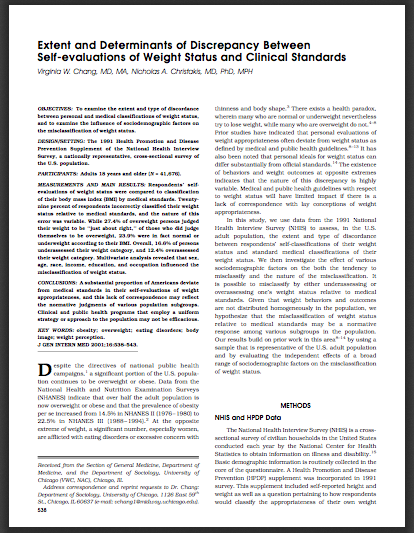
Extent and Determinants of Discrepancy Between Self-Evaluations of Weight Status and Clinical Standards
Abstract
OBJECTIVES: To examine the extent and type of discordance between personal and medical classifications of weight status, and to examine the influence of sociodemographic factors on the misclassification of weight status.
DESIGN/SETTING: The 1991 Health Promotion and Disease Prevention Supplement of the National Health Interview Survey, a nationally representative, cross-sectional survey of the U.S. population.
PARTICIPANTS: Adults 18 years and older (N = 41,676).
MEASUREMENTS AND MAIN RESULTS: Respondents' self-evaluations of weight status were compared to classification of their body mass index (BMI) by medical standards. Twenty-nine percent of respondents incorrectly classified their weight status relative to medical standards, and the nature of this error was variable. While 27.4% of overweight persons judged their weight to be “just about right,” of those who did judge themselves to be overweight, 23.9% were in fact normal or underweight according to their BMI. Overall, 16.6% of persons underassessed their weight category, and 12.4% overassessed their weight category. Multivariate analysis revealed that sex, age, race, income, education, and occupation influenced the misclassification of weight status.
CONCLUSIONS: A substantial proportion of Americans deviate from medical standards in their self-evaluations of weight appropriateness, and this lack of correspondence may reflect the normative judgments of various population subgroups. Clinical and public health programs that employ a uniform strategy or approach to the population may not be efficacious.
Citation:
V.W. Chang and N.A. Christakis, "Extent and Determinants of Discrepancy Between Self-Evaluations of Weight Status and Clinical Standards" Journal of General Internal Medicine, 16(8): 538-543 (August 2001)